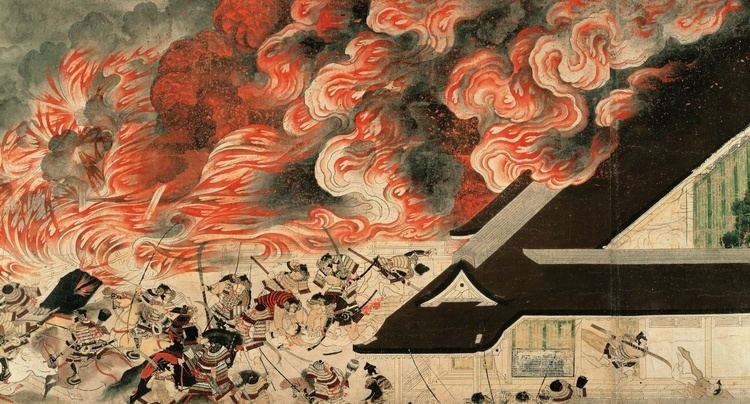 | ||
Similar The Tale of the Heike, Azuma Kagami, Taiheiki, The Diary of Lady Murasaki, Tales of Ise | ||
The Tale of Heiji (平治物語, Heiji monogatari) is a Japanese war epic (gunki monogatari) detailing the events of the Heiji Rebellion of 1159-1160, in which samurai clan head Minamoto no Yoshitomo attacked and besieged Kyoto, as part of an Imperial succession dispute, in which he was opposed by Taira no Kiyomori, head of the Taira clan. The Tale, like most monogatari exists in three main forms: written, oral, and painted.
Contents
The original text is sometimes attributed to Hamuro Tokinaga, and is written in 36 chapters. As is the case with most other monogatari, the text has been rewritten and revised many times over the years, and developed into an oral tradition as well. Most often, the Tale of Heiji would be chanted as a continuation of the Tale of Hōgen, which relates the events of the closely related Hōgen Rebellion.
The picture scroll version of the tale, called Heiji monogatari emaki or Heiji monogatari ekotoba, dates to the 13th century. It tells the tale in color on paper, on five scrolls. Each scroll begins and ends with a written portion of the tale, describing the events depicted in a single continuous painting across the length of the scroll. Perhaps the most famous scene of these five scrolls is the burning of the Night Attack on the Sanjō Palace. The emaki scrolls are currently housed in the Museum of Fine Arts, Boston in Boston, Massachusetts.
Rivalries
The Tale of Heiji presents a conflict between old aristocratic and new military elites. The Heiji story moves beyond from the comparatively simple narration template of the Hōgen monogatari towards a more complicated focus which suggests a need for more nuanced principles and more flexible policies which become more appropriate to desperate times.
As in the Hōgen story, multi-level and inter-related rivalries lead to war; and the main characters are presented in traditional status order: Emperors and former Emperors first, Fujiwara ministers second, and military clan warriors third.
As in the Hōgen story, the narrative structure is divided in three distinct segments:
Monogatari historiography
The Japanese have developed a number of complementary strategies for capturing, preserving and disseminating the essential elements of their commonly accepted national history – chronicles of sovereigns and events, biographies of eminent persons and personalities, and the military tale or gunki monogatari. This last form evolved from an interest in recording the activities of military conflicts in the late 12th century. The major battles, the small skirmishes and the individual contests—and the military figures who animate these accounts—have all been passed from generation to generation in the narrative formats of the Hōgen monogatari (1156), the Heiji monagatari (1159–1160), and the Heike monogatari (1180–1185).
In each of these familiar monogatari, the central figures are popularly well known, the major events are generally understood, and the stakes as they were understood at the time are conventionally accepted as elements in the foundation of Japanese culture. The accuracy of each of these historical records has become a compelling subject for further study; and some accounts have been shown to withstand close scrutiny, while other presumed “facts” have turned out to be inaccurate.
